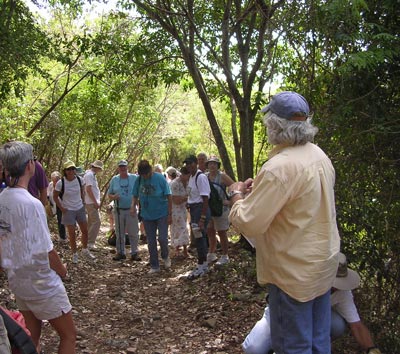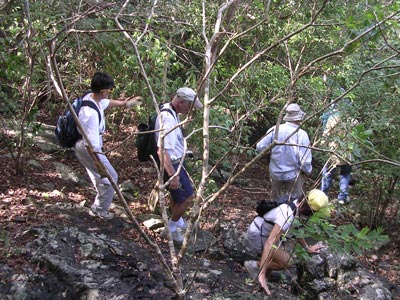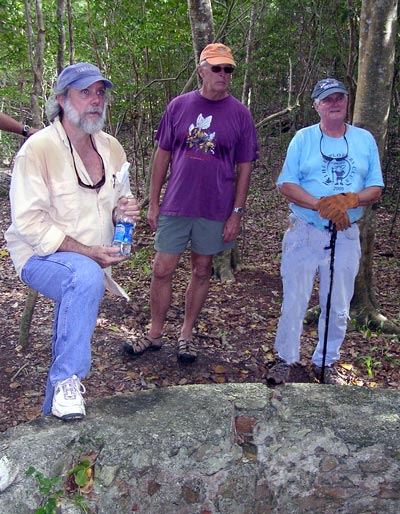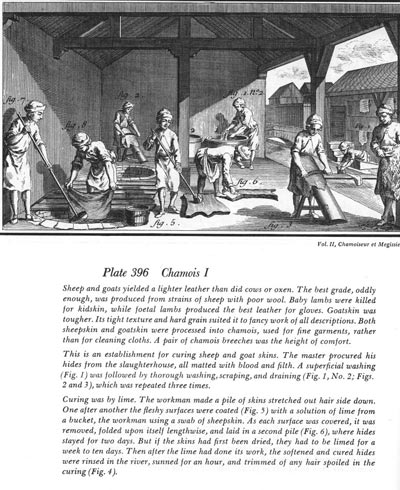Exploring Lieven Marche Bay Estate Ruins
(By David Knight, summarized by Robin Swank)
If you want to learn something new, take a hike!!!
Many of the hikers who joined President David Knight on January 13th had visited Brown Bay, but only a few were previously aware of the Hermitage or Lieven Marche Estates, or of the earlier subsumed and less-documented estate houses and industrial plants that remain along the coral-strewn north shore of the East End.
Before setting out on our hike David explained that British immigrants from the Eastern Caribbean began to take up failing plantations in the area of East End in the mid 1700s. Earlier, this section of St. John was known as the “French Quarter,” because it had been originally settled by French Huguenot families — Constantin, Loisan, Bordeaux, Castan, and Merche — who sought refuge from religious persecution in the liberal, Protestant, Danish colony. British settlers from the Eastern Caribbean, with family names like Moore, Coakley, Turner, Sewer, George and Burck, represent a second wave of Danish-sanctioned settlement in the area. Most of these English families migrated from Anguilla, Peter Island and Spanish Town (Virgin Gorda), where depleted soil, poor climate and geographic isolation had made it nearly impossible to eke out a living. Accustomed to life on the edge, these hearty Creoles readily settled on marginal lands that wealthier sugar planters shunned as unsuitable for agriculture.
David pointed out that one theme apparent throughout St. John is that successive waves of settlers used and re-used existing resources. Most structures and landforms were built over, recycling materials and building sites from earlier times, thus disrupting any cleanly-layered chronological history. Early estates in this area appear to have raised cotton, later converting to mixed agriculture, fishing and cottage industry, along with the grazing of a Creolized breed of sheep and other livestock. Among the diverse activities engaged in during this period was the tanning of hides to meet the huge demand for leather goods (gloves, holsters, bridles and saddles, etc.) stimulated by the Napoleonic conflicts of the turn of the 19th century. The ruins of a tannery and rendering plant at Lieven Marche Bay, our destination for the day, are notable in that they appear to be the only such facility constructed on St. John exclusively for this purpose. (The Caroline’s Lyst Estate on Water Island, off St. Thomas, also appears to have been similarly engaged.)

We trek up the Brown Bay trail to Moore Hill, pausing only for sips of water. Once over the crest of Moore Hill, we take a vote on our route, and then adventurously descend directly to Lieven Marche Bay through the bush. With the ruins of the Marche estate house and laborers’ village above us on the right, we trek down a gut, still damp from last night’s showers, through scattered catch’n‘keep and Genip trees. Along the way David calls our attention to the remains of terracing that line the hillsides around us, evidence of past agriculture land use and an important element of St. John’s rapidly diminishing cultural landscape.
A few large Genip and Tamarind trees provide a shady canopy that helps minimize the brush underfoot. These are old enough, Eleanor Gibney notes, to have been specimen trees when the landscape was cultivated or grazed. As we now better understand the real growth rates of our native plants, it’s certain much of St John was not clear-cut (up until 1800 large sections of St John were still bush), and it makes sense that some trees were left for shade, shelter, or for the fruits and medicinal resources they provided. Many of our stands of trees could not possibly have grown this large in less than 300 years, Eleanor informs us.

Soon the land flattens out and the gut empties into a mud-packed crab pan near a brick and stone well and watering trough, less than 50 yards from today’s beachfront. Wildly varying rainfall, then as now, required water management techniques to store it (in cisterns, ponds and reservoirs) and to access/distribute it (via aqueducts and wells). Although much of the island’s water-intensive sugarcane support infrastructure has eroded off the landscape over time, wells and cisterns were particularly reused. Not far away from the first well is a second with a semi-circular watering trough, dated as mostly late 1800’s by the beach-sand and quicklime mortar. This well of 1800’s sized brick may have used a wind-driven pump, David conjectures, but we can only surmise, as we have lost knowledge of a lot of the technology either imported or developed here. (At Leinster Bay, there appears to have been an ingenious automated wind-driven pumping system at the estate’s sugar works from a very early period). We noted with interest the practice of reuse of earlier materials in both wells on the site.
Although we didn’t see it in our downhill bush-trek, David describes the area as littered with remnants of cattle grazing through the early 1900’s-watchmen’s shacks, and barbed wire fence lines laid out as pens and chutes to route cattle to the watering troughs on the beach and over the hill to Hurricane Hole where the animals were loaded (and/or unloaded) into lighters for transport.

Also scattered in the bush are ruins of smaller subsumed estate houses. A practice incidentally helpful to clarifying timelines was the founding of large estates by the merger of several smaller ones. The conversion factor was generally 3:1, David tells us. Lieven Marche was a huge estate for its time, an extraordinary 4800 feet in width, formed by the acquisition and merging of at least 3 earlier land holdings (Bordeaux, Castan, and Langemak). By following the pattern of taking the most prominent old estate complex as its primary, and abandoning the others to bush, these ‘forgotten’ settlements become important ‘time capsules’ .that is, if not cannibalized for re-use, demolished by fire, wind and weather, or ransacked by those wanting archaeological souvenirs of their St John visit.
We walk a short distance, still close to the beach, to a mid-1700’s site which, David states, has been previously described as an abattoir or slaughterhouse. However, David believes that the cumulative evidence of the site points to its multi-faceted industrial use as a rendering plant, rather than to a mere slaughter-and-eat strategy. While meat was surely butchered and sold for immediate consumption, or dried and salted for future use, the primary function of the facility was certainly a tannery, where hides were prepared for export. Animal fats may also have been extracted here as by-products for use in the production of soap and other fat-based commodities.

The walls of the structure hold early yellow Danish ‘Flensberg’ brick and recycled rubble, overlaid with irregular red brick dating to the mid-eighteenth through early-nineteenth centuries. The existing window openings appear to be lined with a more standard-sized brick of the mid-1800s. These walls clearly indicate reuse of the building over a prolonged time period.
Compelling evidence to support the building being a tannery includes_minified the site location. “History is not so mysterious,” David muses. “If you want to know how things were, simply look at how they are today; patterns of life and man’s necessities are constant.” In places like Brazil and Paraguay, for example, small tanneries resembling the ruins at Marche Bay are still in operation today, and they are always situated at waterside where buildings can be easily sluiced down several times a day — sea water or river water serve equally well for this purpose. Fresh water is also necessary to the tanning process, hence the two nearby wells and a pond (reservoir) on the Marche site.
Quicklime was another key element in the process — tanning requires lime for curing hides – and here again the Marche site had ready access to this material. Lime would have been produced on-site by burning the abundant beach-dried coral heads to a powder. A substitute for Europe’s geological limestone, the ‘discovery’ that quicklime could be produced from coral in the West Indies provided not only an inexpensive renewable hide-curing resource to fuel an industry, but also provided an inexpensive and readily available mortar-hardening agent to facilitate building with brick and stone. It was a discovery which enabled stone houses, windmills, and other more permanent estate structures to be built throughout the colony.
Inside the building, curved brick liners below floor level look as if they once supported two heated vats. The remains of a small furnace and chimney can be observed from the outside. There is no evidence of any industrial use: no crushing mill, molasses catchments or rum still, and no documented estate activity of sugarcane — and the site’s suitability for sugarcane is wrong in any case.
Post-hike conjecture is always a wondrous part of our SJHS experiences. As our group straggles back up to the Brown Bay Trail — some straight up an informal ‘trail’ marked by discarded clothing left by illegal immigrants, some taking the longer route by way of the Brown Bay ruins and Johnny Horne trail; some staying to swim at the once-again deserted Leven Marche Bay — nearly everyone is thinking about the lifestyle of these early settlers and how they used every bit of the resources at their disposal. Storm strewn coral rubble, supplemented with scrap from the ‘stone fishermen’s’ green cut-coral construction blocks, provided quicklime for plaster, mortar and for curing hides. Ashes from fires mixed with animal fat provided raw materials for soap. Land crabs, perhaps penned as they are today in Dominica, (we saw one that was at least crab-cake size!) and turtles, once corralled in shallow bays until needed for dinner, would have been a renewable food source. Bush and trees split for structural walls and pens, and salt ponds managed for salt production were easily accessible.
Would we have been hardy enough and ingenious enough to live here then?
These hikes are great!! We always learn so much, and then we always realize how little we know!!
[Browns Bay][Hermitage][Hurricane Hole][Lieven Marche Bay][Quicklime][Turner Point]
